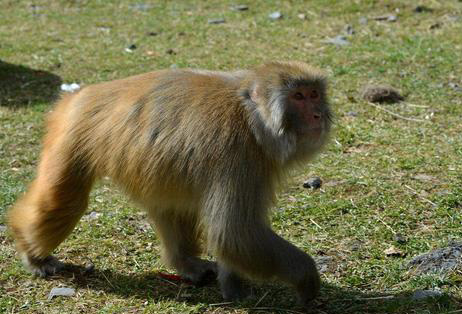Macaca thibetana
IUCN
LCBasic Information
Scientific classification
- name:Macaca thibetana
- Scientific Name:Milne-edwards’ Macaque
- Outline:Primates
- Family:Primates Cercopithecidae Macaca
Vital signs
- length:51-72cm
- Weight:9-18kg
- lifetime:15-20year
Feature
The monkey that can change its face, the largest species of Chinese macaques
Distribution and Habitat
Tibetan macaques are endemic to China, distributed in the central region, east to Zhejiang and Fujian, west to Sichuan, north to the southern Qinling Mountains, and south to the Nanling Mountains.
The altitude of their habitat is 1500-2500 meters. They mainly live in broad-leaved forests, mixed coniferous and broad-leaved forests, or sparse and rocky places in high mountains and deep valleys. They have fixed habitats and often live in caves or cliffs at night, and sometimes spend the night in trees. The vertical altitude range of their distribution is above 400-1900 meters.
Appearance
The body is relatively large. The male is 61-72 cm long, weighs 14-17.5 kg, and has a tail length of 8-10 cm; the female is 51-62 cm long, weighs 9-14 kg, and has a tail length of 4-8 cm. It has a pair of large canine teeth. The male has a flesh-colored face, white eyes, and black bristles on the brow ridge; the female has a red face and pink eyes. The whole body is covered with sparse and long hair, the back is darker, the abdomen is lighter, and there is often a spiral hair on the top of the head.
The face changes color with age, bright red when sexually mature, and purple, flesh-colored, and black when old. The male monkey has a dark brown head, a tan back, and black near the base of the tail; the ventral surface and the inner side of the four gums are light yellow, and the outer side of the limbs and the back of the hands and feet are brown.
In addition, the hair color of the female monkey is lighter than that of the male monkey. The hair color of the juvenile is light brown.
Details
The Tibetan macaque is a species endemic to China and is also the largest species of the Chinese macaque genus.

The Chinese name "Tibetan macaque" first appeared in the "Zoological Dictionary" published in 1922 because its Latin name used a place name "Tibet", but in fact, Tibetan macaques are not native to Tibet.
There are four subspecies of Tibetan macaques, among which the most well-known is the subspecies in Mount Emei, Sichuan, which is called "Emei macaque". This monkey is not afraid of humans and can live in peace with tourists. After the 1990s, due to the great increase in the number of "Emei macaques", and with the opening of the Emei Mountain Tourism Highway and the passenger aerial cableway, some groups began a "historic" large-scale migration, expanding their territory to more than 60 square kilometers, and some even moved around the main peak "Golden Summit" with a higher altitude. Tourists staying in the mountains should be careful to prevent themselves. If the windows are not closed tightly, sometimes many "uninvited guests" will suddenly appear in the room. They gather on the bed, bench, table, and floor, rummaging through the boxes and cabinets, making a lot of noise.
Due to the blind reclamation of humans, the broad-leaved forests have been destroyed, making the living area of Tibetan macaques increasingly narrow. There are still a certain number of them in Wuyi Mountain, Maoer Mountain and Tangjiahe Nature Reserve. So far, there has been no quantitative survey, but it is understood that the number of counties with a large number can reach thousands, while the average county has only a few groups, about one or two hundred, and the number of counties with a small number is only dozens. Based on this, it is estimated that the population of this species should be more than 10,000.
Because Tibetan macaques live in mountainous areas and often use crops as a supplementary food source in autumn, they are often listed as pests and eliminated, resulting in an increasingly scarce population. Tibetan macaques have been listed as a Class II national key protected animal in China. Due to the decreasing population, the competent authorities have noticed that the approval of capture is strictly controlled, especially in nature reserves such as Wolong, where hunting of Tibetan macaques is strictly prohibited. It is distributed in the Fanjing Mountain and Leigong Mountain Nature Reserves in Guizhou.
It is listed as a second-class protected animal in China's "National Key Protected Animal List".
It is listed in the 2013 Red List of Endangered Species of the World Conservation Union (IUCN) ver 3.1 - Near Threatened (NT).
It is listed in the second class of the "National Key Protected Wildlife List of China".
Protect wild animals and stop eating game.
Maintaining ecological balance is everyone's responsibility!








